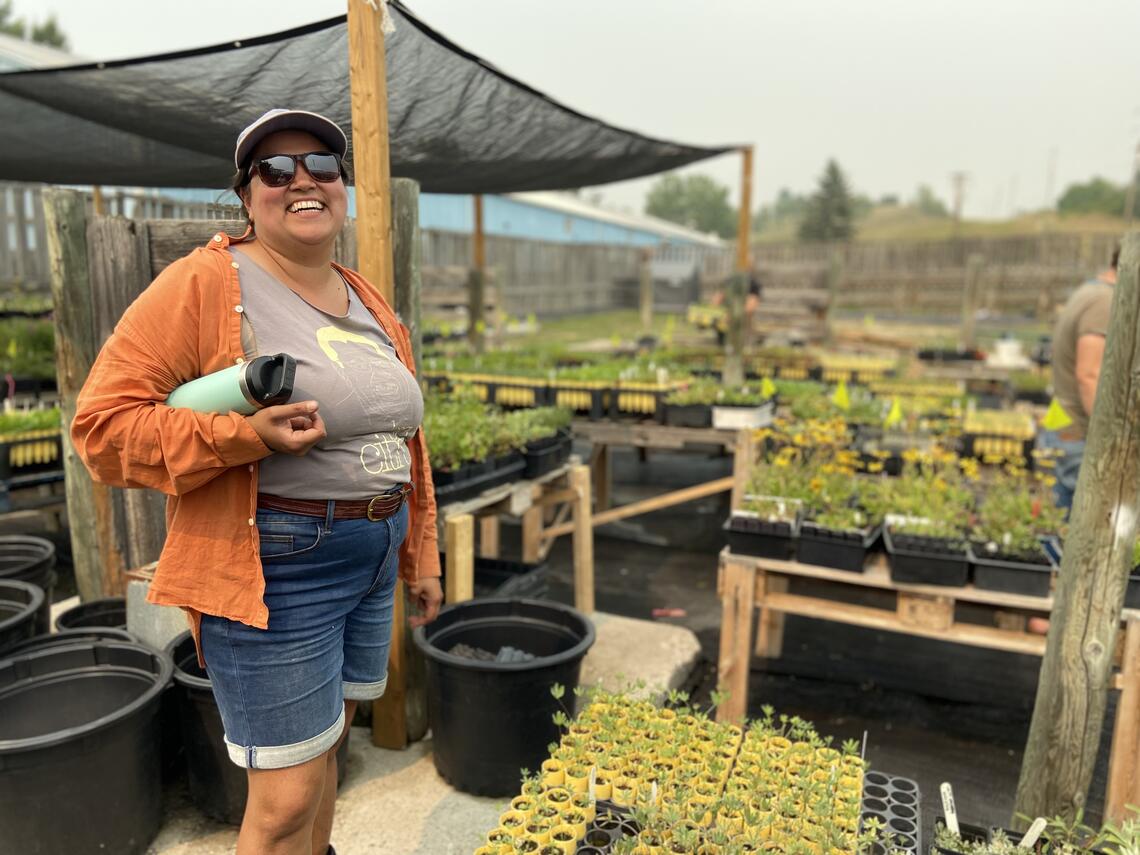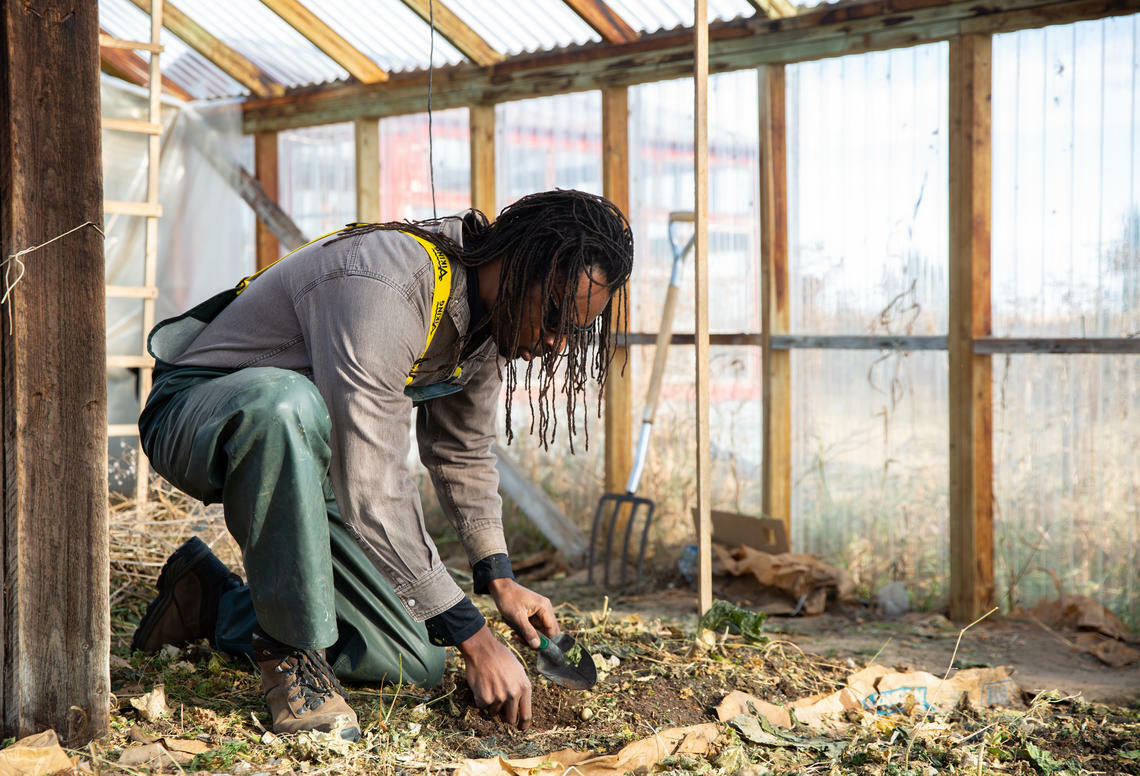
Latifa Pelletier-Ahmed, BSc’09, at ALCLA Native Plants Nursery in Bearspaw, where 150 different species of plants can be purchased. Tours are also available.
May 8, 2023
Editor’s Note: Today marks the start of a new monthly addition to Alumni News — High Five! Think of it as a little mashup of advice and DIY hacks. What you’ll find in each edition are five snappy tips with some helpful takeaways, such as today’s pointers on why and how we should all garden.
Let’s imagine you were tripping about Zimbabwe some 30-odd years ago and say, somehow, you met Tatenda Mambo. Perhaps you spied him playing basketball or found him jamming in a band (two things he loved as a teenager)? Where you most certainly would not have found him was tilling the earth in a garden.
“Never,” says the postdoc in the School of Architecture, Planning and Landscape (SAPL), who also teaches in the Sustainability Studies program at UCalgary. “My parents had a garden but, honestly, I thought of it as a chore.”
Today, however, you can’t keep Mambo, PhD’16, away from the earth. With research projects spanning sustainable food systems and regenerative agriculture, he’s led numerous initiatives from the experimental Simon Farm project to his involvement in the Land of Dreams, a garden for newcomers to grow crops while respecting Indigenous roots. But, these days, gardening for Mambo is far more than developing innovative farm and food systems models.
“Gardening does so much for me,” says the farmer-researcher, espousing its mental, physical and social benefits. “It allows me to block out all the noise and chatter of my world. I find having my hands in the soil so gratifying . . . When I am interacting with the soil I am working at a different pace. It’s where I am most in the moment. I love it.”
May you find such poetry in a patch of earth, whatever the size, hopes Mambo, who (along with other alumni) offers some tips for claiming a sliver of land (or a window box) as your very own wedge of bliss.
If you’re just beginning to dig into gardening, don’t take on acres — just find a small space (or a raised bed) that doesn’t require very deep soil, and start there. Kye Kocher, BA'11, former president of YYC Growers and now owner of Corner Veggies Farm, (just outside of Fernie, B.C.) suggests you “grow what you eat.” Kale, arugula, Swiss chard, lettuce, radishes and garlic and squash can be prolific, he adds. “Focus on the plants that you find yourself typically cooking, because I imagine that you'll put more care into veggies you're interested in eating. But also, grow several things. You'll find success with some and not with others, but this will vary year to year. By having diversity, you'll have more resilience.”
As for tomatoes, that Mambo confesses, “so many people want to plant,” he recommends planting the cherry variety, not Roma or Beefsteak. “The bigger varieties often take too long to ripen, where you’ll actually be able to enjoy ripe and juicy cherry tomatoes by the end of summer, if not sooner.”

Latifa Pelletier-Ahmed, BSc’09, at ALCLA Native Plants Nursery in Bearspaw, where 150 different species of plants can be purchased. Tours are also available.
We know plants support pollinators and native wildlife, but spend an hour with Latifa Pelletier-Ahmed, BSc’09, at ALCLA Native Plants Nursery in Bearspaw and you’ll never look at a milkweed leaf the same (the only leaf on which monarch butterflies lay eggs). Or, after discovering that a single pair of breeding chickadees require 6,000-9,000 caterpillars to feed one clutch — well, you may just buy a tree that supports caterpillars, along with hundreds of other species that are good for the birds. And the bees. ALCLA sells 150 different species of grasses, shrubs and plants and offers tours that are loaded with heartening (and heartbreaking) stories of biodiversity. Popular native plants that fare well in Calgary include bee balm, lupins, alpine forget-me-nots, yarrow, paintbrushes and golden tickseed, says Pelletier-Ahmed.
If you’re a rookie gardener or you don’t have much space, start with a few pots on your deck or balcony. Next, fill them with herbs. Although most of us love basil, it can be persnickety to grow in Calgary, due to our chilly nights. But, if basil is your preferred herb, plant it in a large pot in a sheltered spot close to the house and cover or bring it inside when the temperatures drop. Most herbs thrive in a sunny, sheltered spot; the ones you’ll likely have the most success with include mint, rosemary, tarragon, chives and oregano.

Dr. Tatenda Mambo, PhD’16, at Simon Farm.
If you’ve had a garden before and wish to enrich or “build (and not degrade) your soil as you grow food,” Mambo suggests adding mycelium to mulch. Mambo has grown mushrooms in all sorts of waste — one of his most successful experiments was a mix of spent coffee grinds, straw and sawdust — and suggests that experienced gardeners should experiment with mulch layers to which they could add mushrooms. Here’s a ready-to-try idea: (1) Buy a mushroom kit (say, from Garden Retreat), follow the instructions and enjoy a flush of mushrooms within a couple of weeks. Rather than toss out the used grow block, mix it in with the mulch in a shady part of the garden, keep it moist, and you’ll likely get one or two more flushes of mushrooms during the season. Or opt to plant a hardy mushroom such as a wine cap or an oyster (elm and blue are amongst Mambo’s top choices) and follow these instructions. “What’s missing in so much soil is fungi,” adds Mambo. “Mushrooms are an essential part of how we can rehabilitate soil.”
Kerry Ross, MA’16, one of the first accredited green-roof professionals in Western Canada, and a key player behind the green roof at Calgary’s City Hall as well as others at UCalgary, explains why we should welcome the day when weed-whackers appear on our rooftops:
· Green roofs eat CO2 and produce oxygen, cleaning the air.
· Biodiverse roofs, whether they are homes to herb gardens, aviaries or goats, act as natural insulators and use up to 70 per cent less energy in the summertime by lowering temperatures.
· They reduce quantity and improve quality of storm water runoff.
· Air quality improves, which translates to savings in the form of reduced health-care costs and emergency room visits.
· Green roofs last twice as long as conventional ones.
· They can decrease noise levels by up to 50 decibels.
If you’re curious about green roof designs and what’s been dubbed as “living architecture,” contact Ross at Green T Design Inc.
As Mambo and Kocher like to remind us, even if you’re not good at gardening, gardening is good for you. And for the planet. Sure, a wee window box may not make a major difference ecologically, but it has plenty of other benefits. From our heads to our hearts, gardening will keep our egos in check and, simply, what gardener hasn’t been humbled in their quest to grow things?